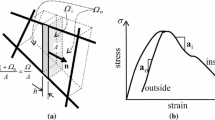Abstract
The performance of finite element methods for dynamic crack propagation in brittle materials is studied. Three methods are considered: the extended finite element method (XFEM), element deletion method and interelement crack method. The extended finite element method is a method for arbitrary crack propagation without remeshing. In element deletion methods, elements that meet a fracture criterion are deleted. In interelement crack methods, the crack is limited to element edges; the separation of these edges is governed by a cohesive law. We show that XFEM and interelement method show similar crack speeds and crack paths. However, both fail to predict a benchmark experiment without adjustment of the energy release rate. The element deletion method performs very poorly for the refinements studied, and is unable to predict crack branching.
Similar content being viewed by others
References
Ravi-Chandar K and Knauss WG (1984). An experimental investigation into dynamic fracture: II. microstructural aspects. Int J Fract 26: 65–80
Ravi-Chandar K and Knauss WG (1984). An experimental investigation into dynamic fracture: III. on steady-state crack propagation and crack branching. Int J Fract 26: 141–154
Ravi-Chandar K (2004). Dynamic fracture. Elsevier, Boston
Marder M and Gross S (1995). Origin of crack tip instabilities. J Mech Phys Solids 43(1): 1–48
Belytschko T and Black T (1999). Elastic crack growth in finite elements with minimal remeshing. Int J Numer Meth Eng 45(5): 601–620
Moës N, Dolbow J and Belytschko T (1999). A finite element method for crack growth without remeshing. Int J Numer Meth Eng 46(1): 131–150
Stolarska M, Chopp DL, Moës N and Belytschko T (2001). Modeling crack growth by level sets in the extended finite element method. Int J Numer Meth Eng 51(8): 943–960
Belytschko T, Moës N, Usui S and Parimi C (2001). Arbitrary discontinuities in finite elements. Int J Numer Meth Eng 50(4): 993–1013
Babuška I and Melenk JM (1997). The partition of unity method. Int J Numer Meth Eng 40(4): 727–758
Belytschko T, Chen H, Xu J and Zi G (2003). Dynamic crack propagation based on loss of hyperbolicity with a new discontinuous enrichment. Int J Numer Meth Eng 58: 1873–1905
Song J-H, Areias PMA and Belytschko T (2006). A method for dynamic crack and shear band propagation with phantom nodes. Int J Numer Meth Eng 67: 868–893
Hansbo A and Hansbo P (2004). A finite element method for the simulation of strong and weak discontinuities in solid mechanics. Comput Meth Appl Mech Eng 193: 3523–3540
Areias PMA and Belytschko T (2006). A comment on the article: a finite element method for simulation of strong and weak discontinuities in solid mechanics. Comput Meth Appl Mech Eng 195: 1275–1276
Réthoré J, Gravouil A, Combescure A (2004) A stable numerical scheme for the finite element simulation of dynamic crack propagation with remeshing. Comput Meth Appl Mech Eng 193:42–44
Réthoré J, Gravouil A and Combescure A (2005). An energy-conserving scheme for dynamic crack growth using the extended fnite element method. Int J Numer Meth Eng 63: 631–659
Remmers JJC, Needleman A and Borst R (2003). A cohesive segments method for the simulation of crack growth. Comput Mech 31: 69–77
Xu X-P and Needleman A (1994). Numerical simulation of fast crack growth in brittle solids. J Mech Phys Solids 42(9): 1397–1434
Camacho G and Ortiz M (1996). Computational modelling of impact damage in brittle materials. Int J Solids Struct 33: 2899–2938
Lemaitre J, Chaboche JL (1990) Mechanics of solid materials. Cambridge University Press, Cambridge. ISBN 0 521 32853 5
Hallquist JO (1998). LS-DYNA theory manual. Livemore software technology corporation, USA
Ortiz M and Pandolfi A (1999). A class of cohesive elements for the simulation of three-dimensional crack propagation. Int J Numer Meth Eng 44: 1267–1282
Fineberg J, Gross SP, Marder M and Swinney HL (1991). Instability in dynamic fracture. Phys Rev Lett 67: 457–460
Sharon E and Fineberg J (1999). Confirming the continuum theory of dynamic brittle fracture for fast cracks. Lett Nature 397: 333–335
Ramulu M and Kobayashi AS (1985). Mechanics of crack curving and branching—a dynamic fracture analysis. Int J Fract 27: 187–201
Ravi-Chandar K (1998). Dynamic fracture of nominally brittle materials. Int J Fract 90: 83–102
Sharon E, Gross SP and Fineberg J (1995). Local crack branching as a mechanism for instability in dynamic fracture. Phys Rev Lett 74(25): 5096–5099
Sharon E and Fineberg J (1996). Microbranching instability and the dynamic fracture of brittle materials. Phys Rev B 54(10): 7128–7139
Fineberg J, Sharon E and Cohen G (2003). Crack front waves in dynamic fracture. Int J Fract 119: 247–261
Lemaitre J (1971) Evaluation of dissipation and damage in metal submitted to dynamic loading. In: Proceedings ICM 1
Kalthoff JF, Winkler S (1987) Failure mode transition at high rates of shear loading. International conference on impact loading and dynamic behavior of materials, vol 1. pp 185–195
Decker RF (1979) Source book on maraging steels. American Society for Metals
Lee YJ and Freund LB (1990). Fracture initiation due to asymmetric impact loading of an edge cracked plate. J Appl Mech ASME 57: 104–111
Kalthoff JF (2000). Modes of dynamic shear failure in solids. Int J Fract 101: 1–31
Sharon E, Gross SP and Fineberg J (1996). Energy dissipation in dynamic fracture. Phys Rev Lett 76(12): 2117–2120
Bourdin B, Francfort GA and Marigo JJ (2000). Numerical experiments in revisited brittle fracture. J Mech Phys Solids 48(4): 797–826
Rabczuk T and Belytschko T (2004). Cracking particles: a simplified meshfree method for arbitray evolving cracks. Int J Numer Meth Eng 61(13): 2316–2343
Papoulia KD, Vavasis SA and Ganguly P (2006). Spatial convergence of crack nucleation using a cohesive finite-element model on a pinwhell-based mesh. Int J Numer Meth Eng 67: 1–16
Author information
Authors and Affiliations
Corresponding author
Rights and permissions
About this article
Cite this article
Song, JH., Wang, H. & Belytschko, T. A comparative study on finite element methods for dynamic fracture. Comput Mech 42, 239–250 (2008). https://doi.org/10.1007/s00466-007-0210-x
Received:
Accepted:
Published:
Issue Date:
DOI: https://doi.org/10.1007/s00466-007-0210-x




